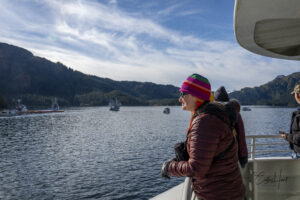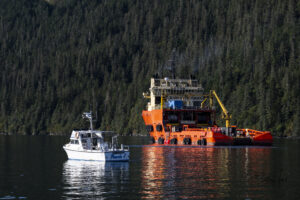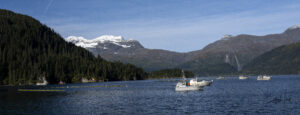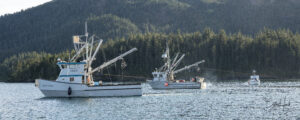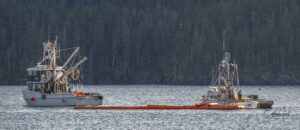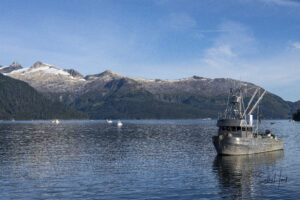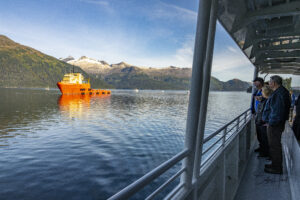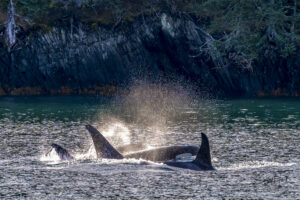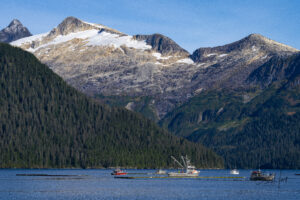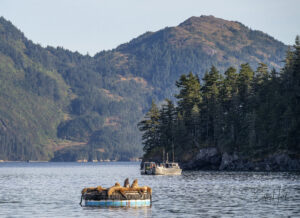Long-time Alaskan, and Council volunteer for over 16 years, Cathy Hart has always had a lot of different irons in a lot of different fires. Her passion for telling stories with photographs winds through almost everything she does, including her work on the Council’s Information and Education Committee.
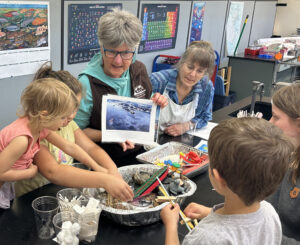
This passion ignited early, not long after her father’s job as an engineer in the oil industry moved the family to Alaska in the late 1960s. The teenaged Hart was exploring her new home state when she spotted an eagle.
“I watched him dive down and get something on the ground,” she recalls.
She was entranced and wanted to capture that moment. She soon got her first camera as a gift from her father.
She found she was good at capturing action shots. She photographed kids’ sports, theater, and dance, and sold the images. Her passion was for the outdoors though.
“Wildlife was always my true love.”
After graduation, Hart went to work for the Alaska Marine Highway, where she worked for 32 years. While she worked there, the Exxon Valdez ran aground in Prince William Sound.
“We had so many cancellations for ferries,” Hart says. “Everyone thought everything was dead.”
The spill spurred her to join the Prince William Sound Tourism Coalition, where she could take an active role in making sure visitors knew that wasn’t the truth. She’s been working to take care of the environment in one way or another ever since.
Photographs capture stories that can’t be fully told with words
When Hart first had the phrase “conservation photographer” explained to her, she says she knew she had found her calling.
“Conservation photographers go out and try to save things.” That’s what Hart tries to do.
As a member of the Alaska Society of Outdoor & Nature Photographers, Hart stepped up when the World Wilderness Congress came to in Anchorage in 2005. This conference is the longest running environmental forum in the world. A fellow attendee was working on one of conference initiatives for that year: the creation of the International League of Conservation Photographers.
“150 of the best conservation photographers in the world landed in Anchorage,” she says. Hart got involved and encouraged other photo club members to help.
“The league was created to work with scientists to bring scientists’ message and projects to laymen,” Hart says. “It’s not all about showing pretty pictures,” she adds. “Our photographs can make a difference.”
Mentoring others to make a difference
Today, she spends a lot of her time volunteering and mentoring younger photographers in a variety of programs.
In 2013, Hart took 15 high school students, mostly from Alaska, to a World Wilderness Congress in Spain.
“The kids had to do a conservation project of their choice, and then present about it at the conference,” Hart says. “Members of the league worked with the kids to help them get their presentations ready, and then the students spoke in front of representatives from 92 different countries.”
More recently, a young student she introduced to photography gave a presentation in Europe about the student’s project documenting salmon spawning grounds in the Kenai River. Hart traveled to watch her presentation. The pride in her voice is apparent as she lists off her mentee’s accomplishments.
“I’ve been on cloud nine ever since!”
She’s currently serving as president of the Alaska Society of Outdoor & Nature Photographers, where she encourages other members to volunteer with her. The group recently worked with Girls Who Click, a nonprofit that hosts free workshops for teen girls to learn about wildlife and nature photography. Hart and other volunteers from the photo club helped the teens learn how to capture images and use them to tell a story. Some of the teens were shy. A few were not fluent in English.
“My goal was to make them smile,” Hart says. “By the end, they were smiling and laughing and stood up in front of the class and talked through her photos.”
Hart also volunteers her time on the Council’s Information and Education Committee, where she and other volunteers plan outreach projects that support the Council’s mission.
One of Hart’s favorite projects is the annual tour of the on-water spill response training. Alyeska’s Ship Escort Response Vessel System pays local mariners to be available to help response to a spill, should one occur. The Council sponsors a vessel in a different community each year and takes residents out on the water to see the training up close. Committee members help develop the project, and as part of her work with the committee, Hart helps tell the story through her photos.
When she first joined the Council, she heard a lot of scientific jargon and felt like she was hearing a foreign language. She leaned on her dad to help her understand.
“He helped me with all the language and the lingo, he was like my secret weapon,” Hart says.
“Some of what we see is very dry and hard to understand what they’re talking about,” Hart says of the Council’s projects. “But if you can attach images to that, it helps people understand.”
Hart’s photos from the recent tour of response training in Whittier, Alaska
Every year, Hart joins the Council on the annual tour of oil spill response training. Below are a few of her photos. Click to view full size image.
